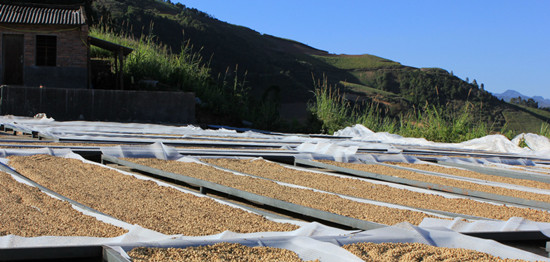Ireta Coffee Manor in Panama introduces the origin of high quality Panamanian coffee bean boutique coffee.
Panama coffee
The microclimate of the Panamanian highlands is the most important resource that makes Panamanian coffee unique. The most important resource that makes Panamanian coffee unique is its microclimate. Panama's east-west environment allows cold air currents to flow through the Central Mountains and converge above 6500 feet, thus creating a variety of microclimates in the Boquete and Volcán-Candela regions, making them the main producers of Panamanian coffee. These specialty coffees are grown on nutrient-rich, well-balanced soil in the Baru volcano region.

planting environment
Panama is a small country located in the heart of the American continent. The waters of the Atlantic and Pacific oceans wash over its beaches.
Panama is located at 9 degrees north latitude, at the confluence of the Central Mountain Range, where Mount Baru, one of the highest volcanoes in Central America, is located.
With an elevation of more than 11,400 feet, the surrounding soil is rich in nutrients and fertile soil, providing sufficient conditions for the planting and cultivation of Panamanian coffee.
These uplands have the right microclimate, soil, temperature and altitude for the planting, cultivation and harvesting of a wide variety of specialty coffees. These coffees have jasmine, citrus, ripe fruit, berry, caramel, special sweetness, vanilla, chocolate and many other flavors.
Unique coffee.
Panamanian coffee is sorted and numbered in small batches designed to be small in volume for optimal management, and the sorting number allows buyers to understand and track information throughout the process.
Due to its small volume, Panamanian coffee products are based on specialty coffee. The country supplies its quality products to specialist stores in countries around the world such as Denmark, England, Greece, Norway, Sweden, South Korea, Japan, Taiwan and the United States.
Café de Eleta is located in a small area of Santa Clara, just one kilometer from the Costa Rican border, near La Amistad International Park, a major virgin forest reserve that belongs to Central America. Estates of Elieta began to acquire land in the 1970s, covering an area of about 130 hectares, initially for vegetable cultivation and livestock farming, and only in 1995 for coffee cultivation, under the name Café de Elita S.A. The land area continued to expand and today it has 420 hectares, one of the largest coffee plantations in Panama and one of the best known coffee plantations in Panama. Due to the abundance of water, there is a private hydroelectric power plant of 530kW. In addition to self-contained electricity, surplus electricity is sold to the Distribubución de Electricidad Chiriquí S.A. network.
This batch of coffee has the purest original flavor. Because the coffee washed by Elieta Manor SHB is extracted from high-altitude Kaduai coffee beans, with strong fruit fragrance, flavor characteristics: butter bread, apricot kernel sweet feeling, cane sweet, sour round, complex aroma, moderate sour and sweet taste pleasant.
Important Notice :
前街咖啡 FrontStreet Coffee has moved to new addredd:
FrontStreet Coffee Address: 315,Donghua East Road,GuangZhou
Tel:020 38364473
- Prev

Santa Rita Coffee Manor, Colombia introduces the production of high-quality Colombian coffee beans
Columbia Coffee Columbia Coffee (Cafe de Colombia), which originated in Colombia, is one of the few individual coffees sold in the world under the name of the country. In terms of quality, it has won praise unmatched by other coffee. Compared with other producing countries, Colombia is more concerned with developing products and promoting production. It is this point, coupled with its superior geographical and climatic conditions.
- Next

Costa Rican boutique coffee producing area introduces Costa Rican coffee flavor and characteristic Tarazhu coffee
Costa Rican coffee cultivation was introduced by Cuba in 1779 and exported for the first time in 1820. There are about 32000 coffee farmers, with an average planting area of less than one hectare (10000 hectares) per farmer. Costa Rica has a population of 41 billion (2006), with a coffee planting area of 82500 hectares and an annual production of 1.7 million bags (60kgs per bag). The annual domestic consumption is 380000 bags.
Related
- Does Rose Summer choose Blue, Green or Red? Detailed explanation of Rose Summer Coffee plots and Classification in Panamanian Jade Manor
- What is the difference between the origin, producing area, processing plant, cooperative and manor of coffee beans?
- How fine does the espresso powder fit? how to grind the espresso?
- Sca coffee roasting degree color card coffee roasting degree 8 roasting color values what do you mean?
- The practice of lattes: how to make lattes at home
- Introduction to Indonesian Fine Coffee beans-- Java Coffee producing area of Indonesian Arabica Coffee
- How much will the flavor of light and medium roasted rose summer be expressed? What baking level is rose summer suitable for?
- Introduction to the characteristics of washing, sun-drying or wet-planing coffee commonly used in Mantenin, Indonesia
- Price characteristics of Arabica Coffee Bean Starbucks introduction to Manning Coffee Bean Taste producing area Variety Manor
- What is the authentic Yega flavor? What are the flavor characteristics of the really excellent Yejasuffi coffee beans?

